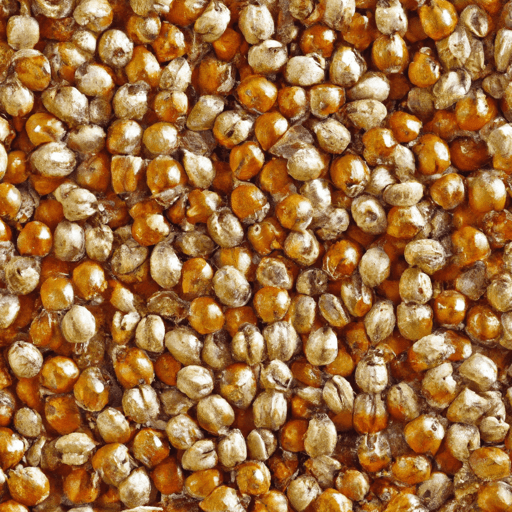The Versatile Bajra Millet: A Powerhouse of Flavor and Nutrition
Are you tired of the same old grains in your pantry? Looking to add a nutritious twist to your meals? Look no further than bajra millet! This ancient grain, also known as pearl millet, is a versatile ingredient that is gaining popularity in kitchens around the world. In this article, we will dive into the wonderful world of bajra millet, exploring its taste, common uses in cooking, nutritional value, and unraveling some interesting history and facts.
The Taste and Texture
Bajra millet has a nutty and earthy flavor that adds a delightful touch to your dishes. When cooked, it has a slightly chewy texture, making it a unique addition to both savory and sweet recipes. The flavor profile of bajra millet pairs well with various ingredients, allowing you to experiment and create a wide range of delicious dishes.
Common Uses in Cooking
From breakfast to dinner, bajra millet can be incorporated into various recipes. Here are a few common ways to use this versatile grain:
1. Bajra Roti (Flatbread)
Bajra roti is a traditional Indian flatbread made from bajra millet flour. It is gluten-free and a perfect alternative for those with dietary restrictions. The rotis are typically served with vegetables, lentils, or dairy products, making for a wholesome and satisfying meal.
2. Puddings and Porridges
Bajra millet can be cooked into creamy and comforting puddings or porridges, ideal for a hearty breakfast or a nourishing dessert. Combine cooked bajra millet with milk or plant-based alternatives, sweeten it with honey or maple syrup, and add your favorite toppings such as fruits and nuts for a delightful treat.
3. Pilaf and Dishes
Bajra millet shines as the star of flavorful pilafs and grain-based dishes. Add sautéed vegetables, aromatic spices, and a protein source of your choice to cooked millet for a satisfying and wholesome lunch or dinner option.
4. Baking
Yes, you can even bake with bajra millet! Incorporate this grain into bread, muffins, or cookies to enhance their nutritional value and give them a unique twist. The nutty taste of bajra millet adds a delightful depth to baked goods.
Nutritional Value
Besides being delicious, bajra millet is a nutritional powerhouse. It is high in fiber, providing a feeling of fullness and supporting healthy digestion. Bajra millet is also rich in essential minerals, including magnesium, iron, and phosphorus. Additionally, it contains antioxidants and important vitamins, making it a great addition to a balanced diet.
Interesting History and Facts
Bajra millet is one of the oldest cultivated grains and has a rich history. It originated in Africa thousands of years ago and later spread to Asia and other parts of the world. This hardy grain can adapt to diverse climates, making it a staple in regions with harsh growing conditions.
In India, bajra millet holds a special place in traditional cuisine. It is often associated with rural communities and is celebrated during festive occasions. Bajra roti is a staple food in the western parts of India, where it is enjoyed with ghee (clarified butter) and a variety of curries.
Give Bajra Millet a Try!
As you can see, bajra millet is not only a flavorful addition to your meals but also a nutritional powerhouse. Its versatility opens up endless possibilities in the kitchen, allowing you to create unique and exciting dishes. So why not give bajra millet a try? Your taste buds and your health will thank you for it!
*Disclaimer: This blog post is for informational purposes only and should not be taken as medical advice.
Bajra Millet
Origin: Bajra millet (Pennisetum glaucum), also known as pearl millet, is believed to have originated in Africa, particularly in the Sahel region. It has been cultivated in Africa for over 4,000 years and is now widely grown in several countries around the world.
Common Uses: Bajra millet is commonly used as a staple food in several Asian and African countries. It is ground into flour to make traditional flatbreads like roti, bhakri, and unleavened pancakes. Bajra grain can also be used for making porridge, pilaf, and as an ingredient in soups and stews.
Nutritional Benefits: Bajra millet is highly nutritious and offers several health benefits. It is rich in complex carbohydrates, dietary fiber, and protein, which helps in providing sustained energy and promoting satiety. It is also a good source of essential minerals such as iron, magnesium, and phosphorus. Moreover, it does not contain gluten, making it a suitable option for those with gluten sensitivity or celiac disease.
Unique Properties: Bajra millet has unique properties that make it well-suited for cultivation in arid and drought-prone regions. It is a hardy crop that can tolerate high temperatures, low rainfall, and poor soil conditions. This resilience makes it an important crop for regions with challenging agricultural environments.
Historical Significance: Bajra millet has a significant historical and cultural significance in the regions where it is grown. It has been an integral part of diets and culinary traditions for centuries. In certain cultures, it holds ceremonial importance and is used during special occasions and festivals. The grain is also considered an important animal feed, particularly for livestock in Africa.
Bajra millet is a versatile grain that has been a staple food for many societies around the world. Its nutritional benefits, unique properties, and historical significance contribute to its continued popularity and importance in various cultures.




Use the share button below if you liked it.
It makes me smile, when I see it.